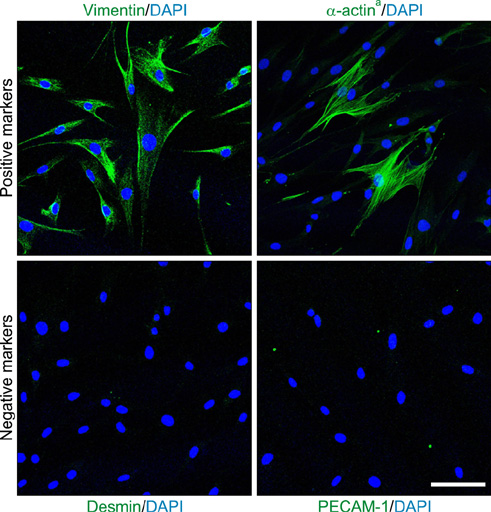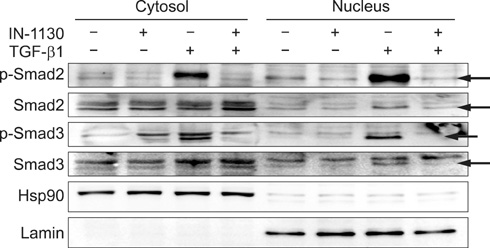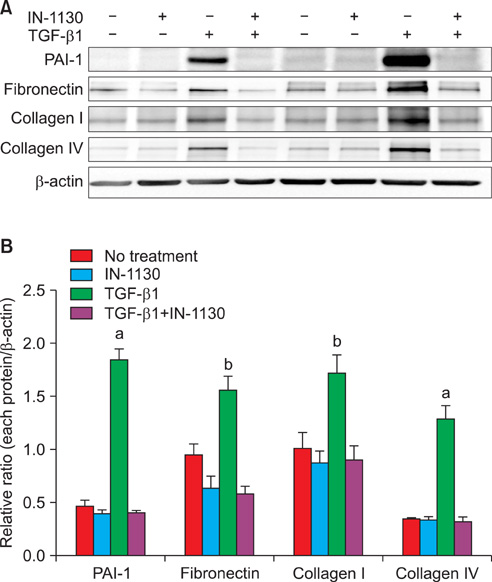Korean J Urol.
2012 Jan;53(1):44-49. 10.4111/kju.2012.53.1.44.
Activin Receptor-Like Kinase 5 Inhibitor Attenuates Fibrosis in Fibroblasts Derived from Peyronie's Plaque
- Affiliations
-
- 1National Research Laboratory of Regenerative Sexual Medicine, Department of Urology, Inha University School of Medicine, Incheon, Korea. jksuh@inha.ac.kr
- KMID: 1988823
- DOI: http://doi.org/10.4111/kju.2012.53.1.44
Abstract
- PURPOSE
Transforming growth factor-beta1 (TGF-beta1) is the key fibrogenic cytokine associated with Peyronie's disease (PD). The aim of this study was to determine the antifibrotic effect of 3-((5-(6-Methylpyridin-2-yl)-4-(quinoxalin-6-yl)-1H-imidazol-2-yl) methyl)benzamide (IN-1130), a small-molecule inhibitor of the TGF-beta type I receptor activin receptor-like kinase 5 (ALK5), in fibroblasts isolated from human PD plaque.
MATERIALS AND METHODS
Plaque tissue from a patient with PD was used for primary fibroblast culture, and we then characterized primary cultured cells. Fibroblasts were pretreated with IN-1130 (10 microM) and then stimulated with TGF-beta1 protein (10 ng/ml). We determined the inhibitory effect of IN-1130 on TGF-beta1-induced phosphorylation of Smad2 and Smad3 or the nuclear translocation of Smad proteins in fibroblasts. Western blot analyses for plasminogen activator inhibitor-1, fibronectin, collagen I, and collagen IV were performed to evaluate effect of IN-1130 on the production of extracellular matrix proteins.
RESULTS
The treatment of fibroblasts with TGF-beta1 significantly increased phosphorylation of Smad2 and Smad3 and induced translocation of Smad proteins from the cytoplasm to the nucleus. Pretreatment with IN-1130 substantially inhibited TGF-beta1-induced phosphorylation of Smad2 and Smad3 and nuclear accumulation of Smad proteins. The TGF-beta1-induced production of extracellular matrix proteins was also significantly inhibited by treatment with IN-1130 and returned to basal levels.
CONCLUSIONS
Overexpression of TGF-beta and activation of Smad transcriptional factors are known to play a crucial role in the pathogenesis of PD. Thus, inhibition of the TGF-beta signaling pathway by ALK5 inhibitor may represent a promising therapeutic strategy for treating PD.
Keyword
MeSH Terms
-
Activin Receptors
Activins
Blotting, Western
Cells, Cultured
Collagen
Cytoplasm
Extracellular Matrix
Extracellular Matrix Proteins
Fibroblasts
Fibronectins
Fibrosis
Humans
Imidazoles
Male
Penile Induration
Phosphorylation
Plasminogen Activators
Protein-Serine-Threonine Kinases
Quinoxalines
Receptors, Transforming Growth Factor beta
Smad Proteins
Transforming Growth Factor beta
Transforming Growth Factor beta1
Activin Receptors
Activins
Collagen
Extracellular Matrix Proteins
Fibronectins
Imidazoles
Plasminogen Activators
Protein-Serine-Threonine Kinases
Quinoxalines
Receptors, Transforming Growth Factor beta
Smad Proteins
Transforming Growth Factor beta
Transforming Growth Factor beta1
Figure
Reference
-
1. Schwarzer U, Sommer F, Klotz T, Braun M, Reifenrath B, Engelmann U. The prevalence of Peyronie's disease: results of a large survey. BJU Int. 2001. 88:727–730.2. Mulhall JP, Creech SD, Boorjian SA, Ghaly S, Kim ED, Moty A, et al. Subjective and objective analysis of the prevalence of Peyronie's disease in a population of men presenting for prostate cancer screening. J Urol. 2004. 171:2350–2353.3. Bella AJ, Perelman MA, Brant WO, Lue TF. Peyronie's disease (CME). J Sex Med. 2007. 4:1527–1538.4. Jarow JP, Lowe FC. Penile trauma: an etiologic factor in Peyronie's disease and erectile dysfunction. J Urol. 1997. 158:1388–1390.5. Devine CJ Jr, Somers KD, Jordan SG, Schlossberg SM. Proposal: trauma as the cause of the Peyronie's lesion. J Urol. 1997. 157:285–290.6. Ryu JK, Suh JK. Peyronie's disease: current medical treatment and future perspectives. Korean J Urol. 2009. 50:527–533.7. Hauck EW, Diemer T, Schmelz HU, Weidner W. A critical analysis of nonsurgical treatment of Peyronie's disease. Eur Urol. 2006. 49:987–997.8. Kadioglu A, Akman T, Sanli O, Gurkan L, Cakan M, Celtik M. Surgical treatment of Peyronie's disease: a critical analysis. Eur Urol. 2006. 50:235–248.9. El-Sakka AI, Hassoba HM, Pillarisetty RJ, Dahiya R, Lue TF. Peyronie's disease is associated with an increase in transforming growth factor-beta protein expression. J Urol. 1997. 158:1391–1394.10. Haag SM, Hauck EW, Szardening-Kirchner C, Diemer T, Cha ES, Weidner W, et al. Alterations in the transforming growth factor (TGF)-beta pathway as a potential factor in the pathogenesis of Peyronie's disease. Eur Urol. 2007. 51:255–261.11. Piao S, Choi MJ, Tumurbaatar M, Kim WJ, Jin HR, Shin SH, et al. Transforming growth factor (TGF)-β type I receptor kinase (ALK5) inhibitor alleviates profibrotic TGF-β1 responses in fibroblasts derived from Peyronie's plaque. J Sex Med. 2010. 7:3385–3395.12. Piao S, Ryu JK, Shin HY, Zhang L, Song SU, Han JY, et al. Repeated intratunical injection of adenovirus expressing transforming growth factor-beta1 in a rat induces penile curvature with tunical fibrotic plaque: a useful model for the study of Peyronie disease. Int J Androl. 2008. 31:346–353.13. Grygielko ET, Martin WM, Tweed C, Thornton P, Harling J, Brooks DP, et al. Inhibition of gene markers of fibrosis with a novel inhibitor of transforming growth factor-beta type I receptor kinase in puromycin-induced nephritis. J Pharmacol Exp Ther. 2005. 313:943–951.14. Bonniaud P, Margetts PJ, Kolb M, Schroeder JA, Kapoun AM, Damm D, et al. Progressive transforming growth factor beta1-induced lung fibrosis is blocked by an orally active ALK5 kinase inhibitor. Am J Respir Crit Care Med. 2005. 171:889–898.15. de Gouville AC, Boullay V, Krysa G, Pilot J, Brusq JM, Loriolle F, et al. Inhibition of TGF-beta signaling by an ALK5 inhibitor protects rats from dimethylnitrosamine-induced liver fibrosis. Br J Pharmacol. 2005. 145:166–177.16. Ryu JK, Piao S, Shin HY, Choi MJ, Zhang LW, Jin HR, et al. IN-1130, a novel transforming growth factor-beta type I receptor kinase (activin receptor-like kinase 5) inhibitor, promotes regression of fibrotic plaque and corrects penile curvature in a rat model of Peyronie's disease. J Sex Med. 2009. 6:1284–1296.17. Mulhall JP, Anderson MS, Lubrano T, Shankey TV. Peyronie's disease cell culture models: phenotypic, genotypic and functional analyses. Int J Impot Res. 2002. 14:397–405.18. Hoodless PA, Haerry T, Abdollah S, Stapleton M, O'Connor MB, Attisano L, et al. MADR1, a MAD-related protein that functions in BMP2 signaling pathways. Cell. 1996. 85:489–500.19. Massagué J, Chen YG. Controlling TGF-beta signaling. Genes Dev. 2000. 14:627–644.20. Isono M, Chen S, Hong SW, Iglesias-de la Cruz MC, Ziyadeh FN. Smad pathway is activated in the diabetic mouse kidney and Smad3 mediates TGF-beta-induced fibronectin in mesangial cells. Biochem Biophys Res Commun. 2002. 296:1356–1365.21. Hong SW, Isono M, Chen S, Iglesias-De La Cruz MC, Han DC, Ziyadeh FN. Increased glomerular and tubular expression of transforming growth factor-beta1, its type II receptor, and activation of the Smad signaling pathway in the db/db mouse. Am J Pathol. 2001. 158:1653–1663.22. Fujimoto M, Maezawa Y, Yokote K, Joh K, Kobayashi K, Kawamura H, et al. Mice lacking Smad3 are protected against streptozotocin-induced diabetic glomerulopathy. Biochem Biophys Res Commun. 2003. 305:1002–1007.23. Macías-Silva M, Abdollah S, Hoodless PA, Pirone R, Attisano L, Wrana JL. MADR2 is a substrate of the TGFbeta receptor and its phosphorylation is required for nuclear accumulation and signaling. Cell. 1996. 87:1215–1224.24. Inman GJ, Nicolás FJ, Hill CS. Nucleocytoplasmic shuttling of Smads 2, 3, and 4 permits sensing of TGF-beta receptor activity. Mol Cell. 2002. 10:283–294.25. Inman GJ, Nicolás FJ, Callahan JF, Harling JD, Gaster LM, Reith AD, et al. SB-431542 is a potent and specific inhibitor of transforming growth factor-beta superfamily type I activin receptor-like kinase (ALK) receptors ALK4, ALK5, and ALK7. Mol Pharmacol. 2002. 62:65–74.26. Laping NJ, Grygielko E, Mathur A, Butter S, Bomberger J, Tweed C, et al. Inhibition of transforming growth factor (TGF)-beta1-induced extracellular matrix with a novel inhibitor of the TGF-beta type I receptor kinase activity: SB-431542. Mol Pharmacol. 2002. 62:58–64.27. Mori Y, Ishida W, Bhattacharyya S, Li Y, Platanias LC, Varga J. Selective inhibition of activin receptor-like kinase 5 signaling blocks profibrotic transforming growth factor beta responses in skin fibroblasts. Arthritis Rheum. 2004. 50:4008–4021.
- Full Text Links
- Actions
-
Cited
- CITED
-
- Close
- Share
- Similar articles
-
- Vactosertib, a Novel, Orally Bioavailable Activin Receptor-Like Kinase 5 Inhibitor, Promotes Regression of Fibrotic Plaques in a Rat Model of Peyronie’s Disease
- Effect of IN-1130, a Novel Transforming Growth Factor-beta Type I Receptor Kinase (ALK5) Inhibitor, on a Rat Model of Peyronie's Disease Induced by Repeated Intratunical Injections of Fibrin
- Clinical Experience with Steroid Therapy in Peyronie's Disease
- Two cases of Peyronie's disease treated by auto-dermal graft technique
- Transforming Growth Factor-beta Type I Receptor Inhibitor Induces Functional and Morphologic Recovery in a Rat Model of Erectile Dysfunction and Cavernous Fibrosis





